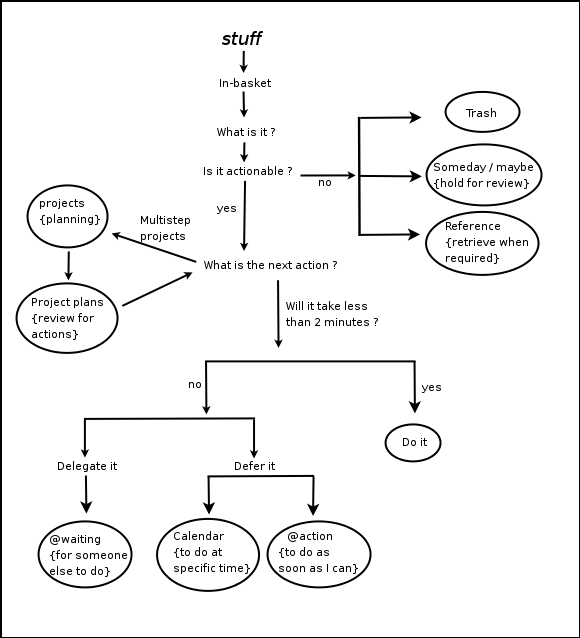Get It Done
This section presents a system for getting things done. It is inspired by Getting Things Done by David Allen – a valuable book which I recommend.
This system takes the e-mails in your In-box, the ideas and reminders in your head, on scraps of paper, in your notebook, your PDA, wherever, and organizes them so that none of them get lots, and the important ones get acted upon.
h2. Gather everything together
Make or buy an in-tray. Then gather those unpaid bills, scraps of paper, books, printouts, TO-DO lists, jot down the ideas from your head, and pile it all in the in-tray. Next do the same for your electronic data, using your e-mail In-box. Most likely there will already be quite a few e-mails in there. E-mail yourself with anything else you need recorded and processed.
Make two special folders in you mail client – one called @action and one @waiting. Make or buy two similar trays for the real world. Buy a sectioned / expanding file. If you haven’t already got a diary, get one.
h2. Process
Once you have everything gathered take e-mails or pieces of paper one by one and run through this diagram:

Everything starts at stuff and ends up in one of the circles.
Calendar should be only actions with a hard date / time (meetings, appointments, birthdays). Things that you would like to get done on a particular day go into Actions.
If needed, Actions can be split by location: Calls, At Computer, Errands, At Office, At Home, Read / Review.
Look at the Calendar daily, first thing. Then look at the Actions list.
Do a Weekly Review of everything – this is whatever needs doing to keep the system up to date – get the ideas in the world onto paper. In a business context, Friday early afternoon is good for this.